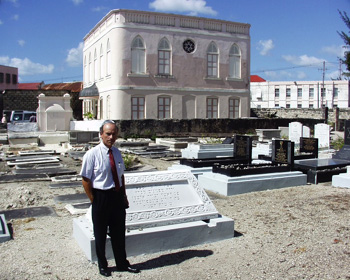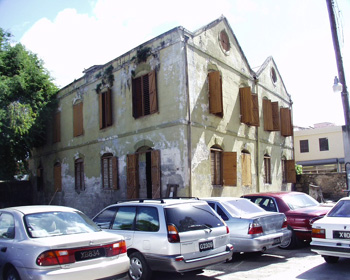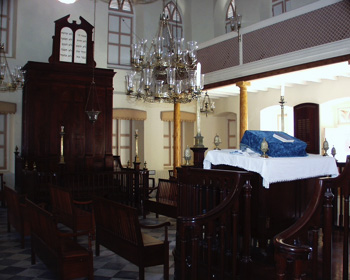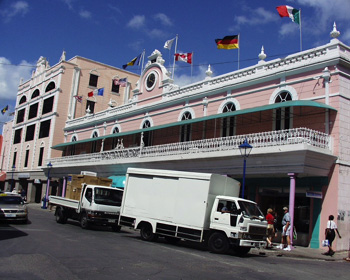Restoration of the Old Synagogue in Barbados
Sunday, May 24, 2009
We were there last summer. Fascinating to see this work in progress! Read the blog post about the Synagogue here.

The current edition of the Reform Judaism magazine includes a fascinating article about the history and restoration of the Nidhe Israel (the Scattered of Israel) synagogue in Bridgetown, Barbados. The synagogue was established in 1654 by Sephardic Jews fleeing the Inquisition. They were joined in the 1660s by a number of Jewish families fleeing Recife, Brazil, where they were being persecuted by the Dutch. Sold in 1929 by the last surviving member of the original founders, the synagogue has now been restored and is now a Barbados protected site and an active synagogue. It houses a new interactive Jewish museum and a recently excavated mikveh, the oldest known in the Western Hemisphere.
The article chronicles the painstaking restoration project, which began in the 1960s and is still ongoing, since recent excavations of the parking lot unearthed the mikveh. The restorations included the adjacent cemetery, which holds crucial information for the reconstruction of the synagogue’s history, and details the efforts made to trace and recover the various ornaments and sacred objects that once belonged to the congregation:
Paul Altman also struggled to recover the synagogue’s eight brass chandeliers, which he traced to the Winterthur Museum in Delaware, the site of the former estate of Henry Francis DuPont. When he appealed to DuPont’s Jewish chairman and CEO, Irving Shapiro reiterated the museum curator’s rationale for denying the request: “If we were to return all our exhibits, we wouldn’t have a museum.” As a consolation, Shapiro told Altman, “We will let you copy them.” Altman pleaded with him, “If we copy them, why don’t we put the copies in the museum with a sign saying, ‘Originals returned by DuPont to the Nidhe Israel synagogue in Barbados.’ How often do you get an offer like that?” Still, Altman says, “It was a no go. The originals remain in the Winterthur and the facsimiles hang in Nidhe Israel.”
Altman had greater success in retrieving the mahogany representation of the Ten Commandments which had hung over the Torah ark. Lady Stella St. John, wife of the Barbados prime minister, had displayed the tablets above the swimming pool of Ilaro Court, their official residence, and graciously donated them back to the synagogue. As the Torah ark and reader’s desk no longer existed, Altman commissioned “a brilliant woodworker” to refabricate them in Barbados mahogany.
The article can be found at http://reformjudaismmag.org/Articles/index.cfm?id=1464
Labels: archeological, Barbados, Jewish, mahogany, Nidhe Israel Museum, synagogue, Winterthur Museum
Thursday, week one: Bridgetown
Thursday, August 28, 2008
Ever since I posted the article I'd found on Nidhe Israel Museum, I knew I wanted to visit. I've always known that one of the earliest-ever synagogues in the western hemisphere was here but I didn't know where it was in Bridgetown, or how to get there.
Then I found out that a local department store had a shuttle to Bridgetown for shopping and I figured we could take that, shop a little, then find the museum and synagogue. I am not a big fan of Bridgetown. The very first year we were here a drunks/doped up man put his arm around our son and started talking to him. Ever since that situation, I've been uncomfortable there. The parking is also a nightmare as are the narrow one-way streets. So, when we've wanted something, we've always shopped at a mall on the coast.
We got on the bus at 8:45 am and headed to Bridgetown. As is usual with these shuttles, we picked up people at 2 or 3 other hotels in Worthing and Hastings before we landed in front of National Heroes Square. This square used to be called Trafalgar Square until 1999 and has a statue of Lord Horatio Nelson in it. This statue was erected 30 years before the one in London. Nelson had sailed to Barbados in 1805. The new memorial, for which the National Heroes Square was named, commemorates Barbadians killed in the two World Wars.
We headed over to Cave Shepherd and bought a few items. The, off to the synagogue and museum. Along the way, I was accosted by someone, presumably not the same person who was interested in our son. He asked for money for "soup" before he was sent on his way.
The Bridgetown Synagogue was just lovely. It dates back to 1654. At that time there was a Jewish population of 300 here. They had left South America and were allowed to settle here. The synagogue was destroyed by a hurricane in 1831 and rebuilt in 1837. Today, the original sand floor has been replaced with tiles but the rest has been kept as it was.
The parking lot is being dug up as part of an archeological project of the University of the West Indies. There were three men working today and we talked extensively with one of them. (pictures to be posted later!) So far, they have uncovered the foundation of a rabbi's house, the foundations of other buildings, pottery and artifacts from the Arawak and Carib Indians. Many of the artifacts are located now in the museum.
The Nidhe Israel (Scattered of Israel) Museum is located in the middle of the synagogue's cemetery. Many of the inscriptions from the tombs are along the walls along with translations. We got a partial, very helpful tour from Celso Brewster, the museum's manager. He explained a lot of the history of the Jewish people before and after they got to Barbados. We learned a little about the Jewish Diaspora; exodus from Spain and Portugal during the inquisition in 1492.
The Dutch were a major naval power then and were colonizing Brazil. Many Jews volunteered to settle in Reclife, Brazil, and they learned about sugar there. Harvesting, marketing, building sugar mills. They brought all these skills to Barbados when they fled Reclife in 1591.
By 1948 there were only 70 Jewish people still on Barbados and by 1925 only one. The Nidhe Israel Synagogue was deconsecrated and sold. In 1931, Askenazi Jews migrated to Barbados from Poland. Moses Altman and his son, Paul, were among these and they rescued the synagogue from demolition in 1989.
Restoration is still going on and I'm sure much about Barbados will be learned from the archeological findings.
The museum shows the sugar trail, and how spices were traded, the history of the Jewish people before and after they arrived in Barbados and much more. Embedded in sand and covered with glass are many of the artifacts dug up outside. These make up much of the floor and it feels a little weird to walk over them.
There were spice exhibits where we got to smell them and guess what they were. There was an interactive display that showed how much time you'd have to work for various products. 30 days for a pound of saffron! Wow!
We went back to our bus meeting place and Tom ran into that same guy from this morning. He actually apologized for hassling us!
Back home and naptime!
Labels: Arawak, archeological, Barbadian, Bridgetown, Carib, Cave Shepherd, Christ Church, Hastings, hurricane, Jewish, Lord Horatio Nelson, National Heroes Square, Nidhe Israel Museum, spices, sugar, synagogue, Trafalgar Square, University of the West Indies, World War, Worthing
Reclaiming the Jewish past in Barbados
Thursday, July 24, 2008
From http://www.jewishsightseeing.com/barbados/bridgetown/sd4-6barbados_synagogue.htm
Who were the 'Bearded Ones?'
Reclaiming the Jewish past in Barbados
San Diego Jewish Press-Heritage, April. 6, 2001
Bridgetown, Barbados (special) --In just a glance, a visitor may see evidence of the decline and subsequent rise of the tiny Jewish community of Barbados.
The 17th-century cemetery is adjacent to the synagogue, which recently has been restored in large measure thanks to the efforts of Paul Altman.

CEMETERY AND SYNAGOGUE-- Paul Altman stands in 17th century cemetery adjacent to original synagogue of Barbados, which has undergone renovation. The grave of his grandfather,
Moses Altman, who led the family's migration from Poland to Barbados in 1931. also is in this cemetery.
When his grandfather, Moses Altman, came to Barbados from Poland in 1931, he found that the Jews had all left the island. Members of the once thriving community had scattered in many directions.
"Some went to Britain because of Barbados being British," Paul Altman told me. "Some went to the United States when the U.S. opened up. The various hurricanes were another reason some left. A lot of them became assimilated.
"Today, Barbadians of all creeds and colors will tap me on the shoulder and say, 'you know my grandfather, or my great-grandfather, left us something from the synagogue and we would like to contribute.'"
In 1925, Edmund Baeza, who then was considered the Caribbean island's last Jewish resident, sold the synagogue which had been capable of accommodating 300 congregants. Baeza donated the proceeds of the sale, amounting to 500 British pounds, to the Bevis Marks Synagogue in London, England.
There had been a longstanding relationship between Bevis Marks Synagogue--which follows the Sephardic rite--and the synagogue in Barbados, which was established approximately in 1654 by Sephardic immigrants from Brazil. While the exact date that the first Jewish settlers arrived in Barbados is not known, it is believed it was as early as 1628--one year after British settlement on this Caribbean island began.

FUTURE MUSEUM-- This old schoolhouse building, adjacent to the old Jewish cemetery, has been obtained by the Jewish community for a future museum.
After Baeza sold the synagogue building to Henry Graham Yearwood, it was used for a variety of purposes, including as a law library, turf club and warehouse. Except for weathering, the adjacent cemetery meanwhile was left unchanged--and now requires considerable renovation.
E.M. Shilstone, a local historian, had proposed to Baeza that the synagogue be maintained as a monument to Barbados' early Jewish settlers, among whom were members of the de Mercado family, who were credited with bringing to Barbados the sugar refining industry. After Baeza rejected his offer of a lower amount of money for the synagogue building, Shilstone carefully photographed the interior of the synagogue as well as the inscriptions on the gravestones in the cemetery.
Among them was an inscription on the tomb of Benjamin Massiah, extolling him for having been "a reader of the Jews' Synagogue for many years without a fee or reward and performed the office of Circumciser with great applause and dexterity..."
Moses Altman supported himself as a peddlar, gradually working himself up to a shop keeper. In 1932, his son Henry, followed him over, and eventually a new Jewish settlement of approximately 40 families took root in Barbados. They built themselves a small synagogue, which they named Shaare Tzedek, in a neighborhood of Bridgetown called Rockley. They continued to use the Jewish cemetery adjacent to the old synagogue building for their burials, however.
So matters stood until the late 1970s, when the government of Barbados acquired the old synagogue building by condemnation and made plans to level it so that the lot it stood on could be used for the expansion of the nearby Supreme Court building.
Historical preservation was far from a governmental priority at the time. In fact, Barbados' original Parliament Building once had stood next to the synagogue, and it was destroyed to make room for expansion. Known as Codd's House, it was a building which had housed some important history. It was there, for example, that the Emancipation Bill had been signed during the 1800s, forever outlawing slavery in Barbados.
As destruction came to Codd's House, so too was it planned for what once had been God's house.
Henry Altman became concerned, however, when the government proposed not only to destroy the former synagogue building, but also to take about 10 feet of the Jewish cemetery, which would require the relocation of some of the bodies buried there.
The Altman family immediately began a campaign to preserve both the synagogue and the cemetery.

RESTORED INTERIOR-- Almost every thing inside the old synagogue in Bridgetown, Barbados-- whether the chandeliers, bima, the reader's table or Ten Commandments-- have stories attached to them attesting to the dedication of the current Jewish community to remembering the past.
Henry Altman had an important ally in his son, Paul, who then was serving on the board of the Barbados National Trust. The son went to the Shilstone Library of the Barbados Museum and found Shilstone's photographs which showed exactly how the synagogue's interior once had looked. So armed, he paid a call on Barbados Prime Minister Tom Adams, who told him "if you can find the money to restore the building, we will give you the building."
Fired up, the small Jewish community in Barbados set about contacting potential allies throughout the world.
"Everyone said we were crazy; 'you will never do it!'" Altman recalled to me during an interview at the old synagogue, located within easy walking distance of the pier where our cruise ship, MV Olympic Voyager, had docked that morning.
"Where were we going to get $1 million U.S. currency to restore an old broken down building which no one might ever use?" Altman asked rhetorically. "We set about our task by simply putting one worker to chip away at the building, because that was all that we had funds for at the time. We told him to tell anyone who came and asked what he was doing to say that he was just getting some facts because a major restoration was starting, and that they could contribute to that."
The preservationist eventually attracted contributions from the Commonwealth Jewish Council in Britian, the American Jewish Congress the Canadian Jewish Congress, and individual donors.

BRIDGETOWN SHOPPING-- The flags of many nations wave over the crowded shopping avenue in Bridgetown Barbados.
"I went and attended various meetings, invited them here, and got people to write articles for newspapers in different areas, and people saw that we were serious," Altman recalled.
With the help of Shilstone's photographs, the community set about to restore the old building to its former self.
"It was like putting a puzzle together," said Altman. "One of the first things we did was we found out that the University of Florida had a program called PIC-- Preservation in the Caribbean. ...They sent us a School of Architecture graduate student who came and spent three months and worked with a firm in Barbados, who offered their services."
The Barbados Museum had a few pieces from the synagogue, like an original bench, and other pieces were located both on the island and elsewhere. Last year, for example, "a lady from the Winterthur Museum came here ... because she wanted to discuss the original chandeliers. But they wouldn't give them back, and I went as far as speaking with Mr. Shapiro, who was then president or chairman of Dupont (which underwrote the museum).
"He happened to be a Jewish man, whom I thought I could appeal to in terms of the cause, but he said it would be up to the curator of the museum and he couldn't impose his wishes on her," Altman recalled. "The feeling was that if you returned artifacts such as those chandeliers to their places of origin, then the museum would cease to have a reason to exist. I argued differently of course. I said this was one opportunity that presented itself, whereas many wouldn't."
Even though the synagogue couldn't recover its original chandeliers, it was able to commission artisans to make replicas, which were installed in the old sanctuary.
Altman was more successful with the "Ten Commandments" which originally had been placed over the aron kodesh. It turned out the tablets "were hanging over the swimming pool in the former residence of an ex governor general of Barbados." Known as Illaro Court, the house later had become the residence of the Prime Minister of Barbados. (I couldn't help but wonder if anyone had posted near the tablets, an 11th Commandment saying "Thou shalt not run near the pool.")
"When we were assembling the (synagogue) building, the Prime Minister at the time was Bernard St. John, who is now Sir Bernard St. John, and his wife, Stella," continued Altman, waving off my dive into humor. "Stella had a particular link with a man called Teddy Reitman, who was the honorary consul of Barbados in Israel. He had befriended the St. John family in Israel, and in fact,they had visited his house near Tel Aviv. Teddy Reitman approached Stella, and Stella was immediately willing. She said 'Come and take them,' and we put them back here."
Local artisans were commissioned to reproduce the old wood bima as well as the reader's table, which faced each other in the configuration typical of Sephardic shuls.
"We have superb craftsmen in Barbados, just like the ones who would have made the original ones back in the 1600's," Altman said. "These were done by a very talented man by the name of Andy Tempro-- our families have known each other for many years. He builds furniture. In fact, he is connected with Princess Margaret's son, Lindsey, who is in the area, and they have a common interest in the reproduction of antique furniture and that type of thing."
Altman said although there were always monetary pressures, he insisted upon quality. "For example, someone said they could do these moldings a lot cheaper if they did them out of fiber glass, and I said 'absolutely not. What was here was wood.' We used mahogany. I suppose because of my National Trust hat and links that I don't believe in synthetics when it comes to doing a restoration of an old building."
During the winter months, the Jewish community holds its services in the old synagogue building, which, as in days of old, has no air conditioning. But during the hot months of summer, they retreat to the smaller, but air conditioned, Shaare Tzedek for their services.
Besides restoration of the old synagogue, Altman has arranged for the repair of the cemetery and plans a Jewish museum in a nearby school house following renovation.
The cemetery project started only after "we had someone we could have 100 percent confidence in. We found that person in Evan Mielner-- a British fellow, who has a degree in stone work, and has experience as a hobby in archeology. ... He has done a tremendous amount of research. He belongs to the Bevis Marks Synagogue...so he understands all the religious requirements that attaches to that type of Spanish graveyard."
Restoration of the cemetery "is a slow process, and he has left instructions for the gentlemen who are here. He (Mielner) comes three months a year and works on his hands and knees with them doing the work and then leaves a detailed set of instructions, and they continue. We have two men who slowly, laboriously, piece by piece, are doing it. If it takes ten years, it will take ten years, but it will be done right and that is my concern."
One of the local artisans is Charles Leslie, "who must be given full credit for what he has done," Altman said. "He has put years of his life into this work, and although he is not Jewish, he considers this his purpose in life to continue this job. He is so committed to it."
Besides repairing broken stones, the team has chiseled onto the stones lost letters, using for guidance inscriptions from Shilstone's book--as well as some records found at the Bevis Marks Synagogue.
I asked Altman to try to put in words what motivates him.
"I will tell you what is in my heart," he replied. "When I walked into this building for the first time, people walked me around and said that these tiles here were the original tiles, although at the time they were so dirty you could hardly see them, and that under the fake ceiling there was another ceiling. As I looked around, I saw the graveyard and I recognized the significance and the history, and I felt a part of it for whatever reason...
"Barbados has something special," Altman added. "It has that history; it has that attachment to the Jewish presence here, the African presence here, the British presence here. "
According to legend, the name " Las Barbados," meaning "the bearded ones," in Portuguese, refers to a type of fig tree found on the island by explorers. While he can't disprove the legend, Altman prefers his alternative explanation for the island's name.
"If you check anywhere in Barbados, the only Portuguese names that are in Barbados, and the ones which are from the original settlement, are in this graveyard," he said. "So I suggest that 'Las Barbados' really referred to those bearded Jewish settlers who came here..."
Who'd have thought? A Jewish island!
Labels: Bridgetown, Caribbean, Jewish, National Trust, Nidhe Israel Museum, Rockley, sugar, synagogue, Winterthur Museum


